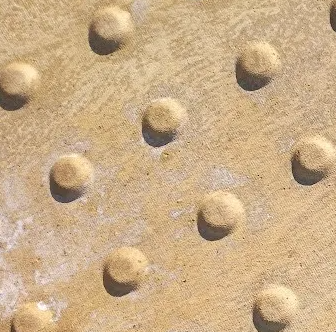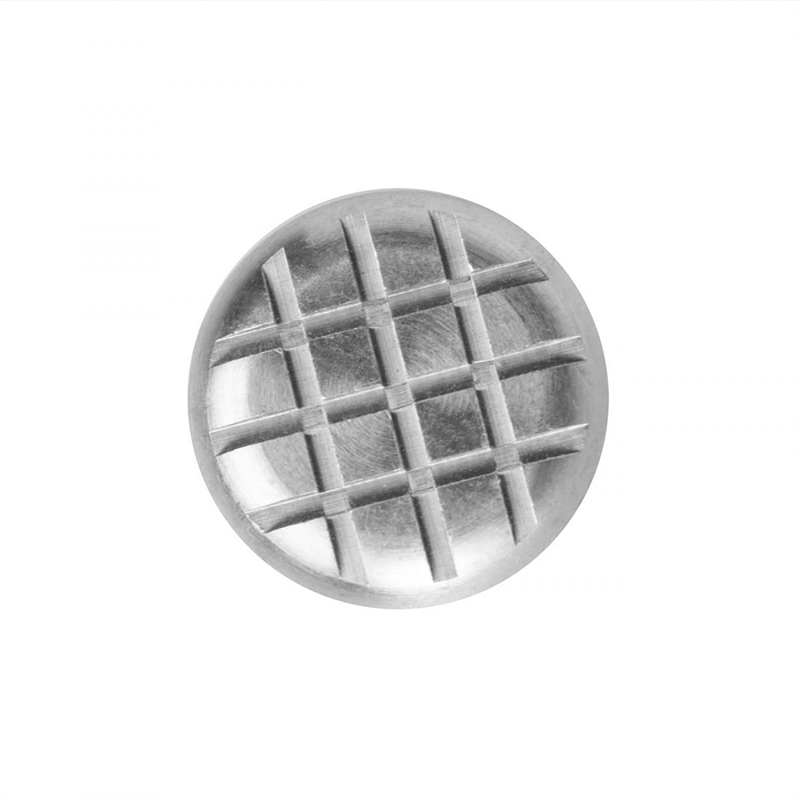Generally, any standard 25mm width, 5mm height tactile stud can recreate blister paving, but some shapes and patterns are better suited than others. If we examine blister paving, we notice that the blisters themselves are semi-dome-shaped leading up to a flat top with small perforations.
Which tactile stud will accurately recreate blister paving?
Recreating Blister Paving
In some scenarios, it can often be advantageous to recreate blister paving using tactile studs in place of their traditional concrete slab counterpart. This can be due to things like aesthetics, longevity, site access, or wanting to reduce the level of disruption during their installation. This article will examine what blister paving is, why tactile studs can be a preferential alternative, and which stud most accurately recreates blister paving.
What is Blister Paving?
Blister paving is a common site internationally as it’s a universal signal that the pedestrian is approaching a hazard and needs to either stop or change their walking speed. The tactile feeling alone is enough to let the visually impaired user know what to expect and how to adjust their gait to react to a potential obstacle or hazard.
Blister paving also comes in two colours, buff/yellow and red. Buff or yellow signifies an uncontrolled crossing, meaning that there is nothing in place to actively halt traffic flow so that the pedestrian may cross. Red signifies a controlled crossing, a crossing that has signal lights or other means of stopping traffic. These two colours are chosen to represent these key situations due to the level of contrast with typical substrates such as concrete or tarmac. The contrast helps the visually impaired utilise whatever residual sight they possess.
Why are tactile studs a good substitute for Blister Paving?
Tactile studs have several benefits over traditional concrete blister paving slabs, namely:
-
Durability
Metal tactile studs have the advantage over concrete studs due to their harder-wearing nature. This isn’t just referring to their ability to stay intact over time but their ability to continue to perform consistently. Over time concrete blisters are gradually chipped away and worn down due to footfall, whereas metal tactile studs don’t see anything like the same amount of wear.
-
Cost-effectiveness
Increased durability means less of a propensity to need replacing. For permanent fixtures on the streets, metal tactile studs work out much more cost-effective over long periods of time. Concrete blister tiles will need to be replaced due to wear and the associated costs of procurement and installation building up over time. This isn’t the case with metal tactile studs.
-
Aesthetics
Beauty is very much in the eye of the beholder, but in the case of tactile studs there are multiple designs and patterns to choose from.
-
Consistency
Due to their metal construction, tactile studs continue to perform over extended periods in any weather type whilst providing ample tactile feedback. They also suffer less when it comes to maintaining friction in the face of contaminants such as oil, diesel, or water.
-
Easier application
Installing tactile studs is much easier using a drill and resin approach when compared to installing concrete blister paving. The amount of tools and manpower needed is much less than when installing blister paving. The same also goes for uncommon arrangements or obstacles as they can be laid out in a pattern that avoids or takes them into account.
-
Less disruptive installation
Due to the relative ease of installation and the requirement for fewer tools and manpower, tactile studs are much less disruptive when it comes time to install them. There is no need to close roads and dig up the underlying surfaces as tactile studs are easily retrofitted to the existing substrate.
-
Repairability
Tactile studs are easily repairable using the same method that was used to install them. In the rare instance that a stud is broken or comes unseated, a replacement can be affixed back into place using resin. In the case of concrete blister paving, if a tile is split or broken during use a replacement will need to be re-laid causing disruption, and requires a substantial amount of tools and safety precautions such as lane closures.
Which stud most accurately recreates blister paving?


Ideally, to recreate the same sensation underfoot, it’s a good idea to match the shape as closely as possible. Amongst our range, the SQ stud is a near-perfect copy of the blisters on blister paving. It features the same semi-dome-shape with a flat top, allowing it to convey the warning message accurately and effectively to the visually impaired.
For information on the patterns and spacings for installing tactile studs in place of blister paving – click here
